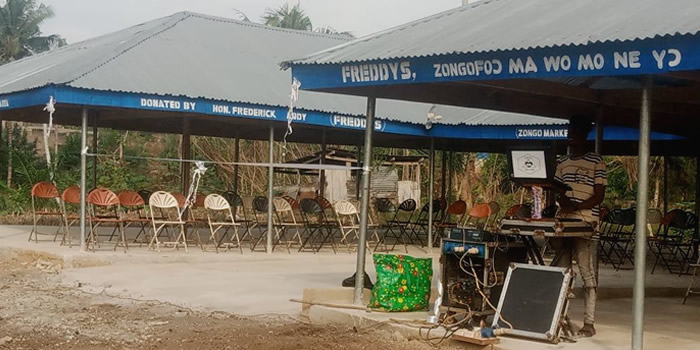

Location and Size
The District is located in the Mid-Western part of the Western region of Ghana. It is bordered to the North, South, East and West by Bodi, Aowin, Sewfi Akontombra Districts and the republic of La Cote D’Ivoire respectively. The District capital is Dadieso which is about 300km from Sekondi-Takoradi, the regional capital. The District covers a total land area of 400.14 square kilometers.
Relief and Drainage
The District is located within the forest belt of the Western Region with an undulating topography made up of Highlands and Lowlands that are interspersed with fast flowing rivers and marshy lands. The highest points of the District rise between 305 meters and 400 meters above sea level at Karlo, Kwabenakrom, Obengkrom, AsuoPokuaa and ‘Peace’. These highlands serve as the sources for most of the streams and rivers in the district. The lowlands are generally marshy and support rice cultivation and Aqua culture.
The District is drained by three major fast flowing rivers. These are BIA, Fanoma and Sui. They flow all year round and therefore serve as source of fishing. There are also several perennial or seasonal water bodies such as Ndoria, Nana BulluAsue, Asuopiri, and Asuopokuaa. The drainage pattern is basically dendritic. The District is therefore well drained with enhanced soil fertility that supports the cultivation of both food and cash crops.
Figure 1.3: Drainage Map of Suaman District
Climate
The District is located within the wet-semi Equatorial climatic zone of the West African Sub-Region. The District therefore receives nine (9) months of rainfall with two peak periods in May and June, and September and October. Generally, the annual rainfall ranges between 1500mm and 1800mm. Temperatures are generally warm in the District ranging between 280C and 370C. The highest temperatures are recorded between February and March while the lowest is in August.
Vegetation
The District entirely falls within the High Rain Forest Vegetation Zone and therefore has major forest reserves. Prominent among them are the Dadieso forest reserve at mile four and the Densu River reserve. Most of the water bodies that drain the District take their source from highlands that are located in these forest reserves. There are also patches of Secondary forests in the District. Several timber species are found in these reserves. Examples include Odum, Wawa. Sapele, Mahogany, Danta, Danwoma, Ofram, Amire. About 65-70 percent of the vegetation cover is made up of cocoa plantations that translate into about 26,000 of hectors.
Geology and Minerals
There are three main types of rocks found in the District namely; the Birimian type, the isolated partly metamorphosed rocks and isolated Granite rocks. A greater proportion of the soils contain the Birimian and partly metamorphosed rocks. Most of these rocks are rich in minerals such as iron and gold. There are large deposits of granite at the southern parts of the District which is very good for road and building construction. The figure 1.5 below depicts the geology map of Suaman District.
Soil
The soils are mainly the forest Ochrosols which is highly coloured, brown - red, orange and not leached. There is also heavy accumulation of Humus in the soils with high moisture content. The soils support the growth of many tree crops such as cocoa, coffee, orange and rubber.
The combination of these rock types and the resultant formation of different soil types tend to support different Agricultural activities. For example, the forest Ochrosols supports the cultivation of cocoa, cashew, coffee and a variety of food crops. The marshy areas which are made up of clay soils also support the cultivation of rice and sugar cane.
The figure 1.6 below depicts the soil of Suaman District.
Environmental Situation
Conditions of the Natural Environment
Although the District is endowed with natural resources such as water bodies, rock deposits, forest and gold, the state of these resources are varied. Illegal felling of timber, encroachment of forest through farming activities and pollution of water bodies are some of the challenges confronting the existence of some of the natural resources. Farming and extensive logging for example have contributed to fast depletion of the forest resources in the district.
There are evidences that forest reserves in the District have been greatly encroached upon as a result of farming and logging activities. The forest reserve in the District is among a few relics in the country. The benefits in terms of providing natural habitats for Fauna and Flora of rare species, protection of watersheds, creation of micro-climatic conditions and contribution to the prevention of global warming are critical for human existence and therefore have to be protected to serve future generation.
Dumping of refuse along water bodies is also a major negative effect of human activities on this resource which serves as a source of water for household activities, fish farming and dry season farming.
Conditions of the Built Environment
The settlements in the District are nucleated in pattern. Buildings are mainly made of mud (land Crete). Most of the houses lack sanitary facilities such as household toilets. Highly improved solid waste management systems for household are limited to a few households.
Only Dadieso the District capital have Planning schemes or layouts for effective management of their spaces for a more effective land use Development. Ironically, the town has not engaged a Professional Surveyor to lead land allocation processes for efficient maximization of space. Haphazard land development and construction activities with no regard for layouts and building regulations constitute a major challenge to settlement Planning and Development in District.
Apart from Dadieso, the District capital, which can boast of a few drainage structures, which are not completed, the rest of the major settlements do not have such a facility. Domestic waste water therefore flows all over these settlements creating ponds and unsanitary conditions for breeding of insects.
The figure below shows Suaman District land cover
Date Created : 11/18/2017 11:37:25 AM











 facebook
facebook
 twitter
twitter
 Youtube
Youtube
 +233 593 831 280
+233 593 831 280 0800 430 430
0800 430 430 GPS: GE-231-4383
GPS: GE-231-4383 info@ghanadistricts.com
info@ghanadistricts.com Box GP1044, Accra, Ghana
Box GP1044, Accra, Ghana